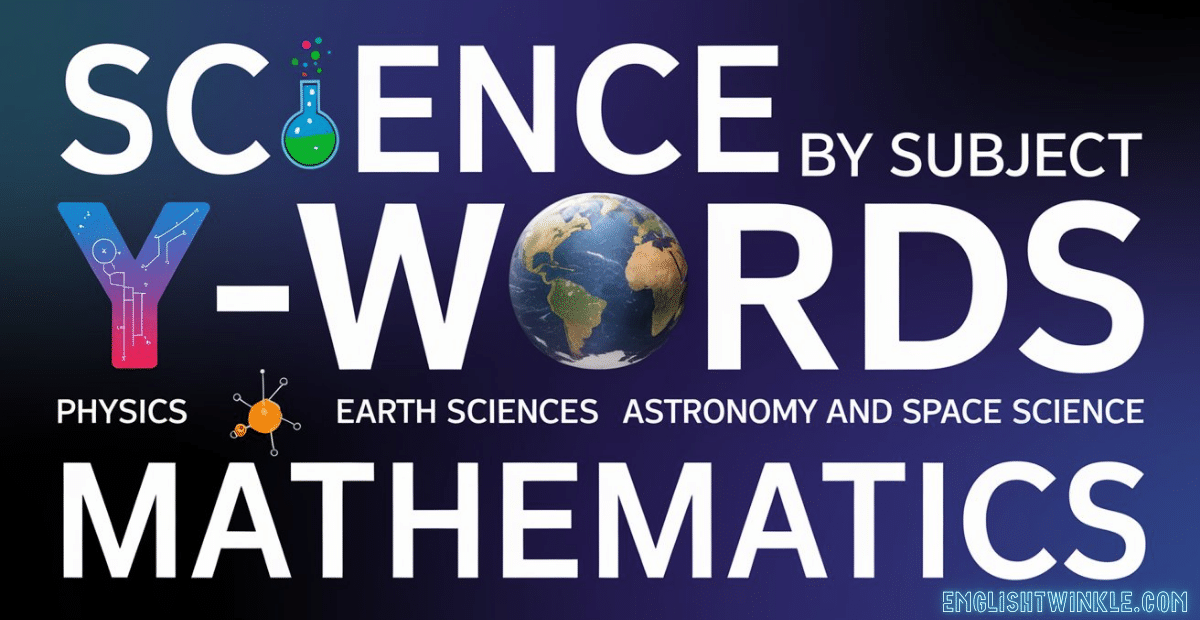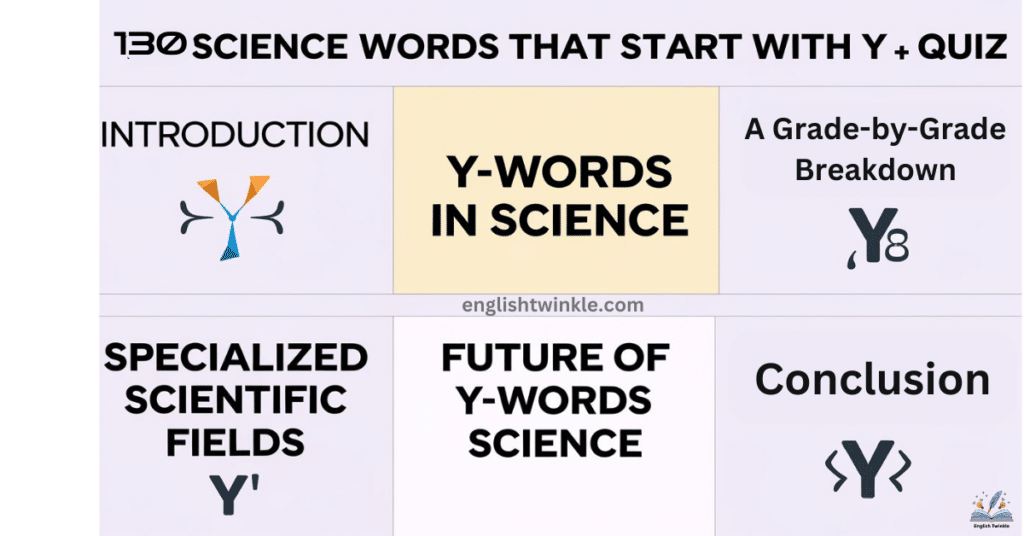Introduction: The Power of Scientific Vocabulary
Words that start with Y might not be as numerous as those beginning with other letters, but they encompass a wide range of crucial scientific concepts. From the Y-axis in mathematics to Yttrium in chemistry, these terms open doors to fascinating areas of study and groundbreaking discoveries.
Scientific terminology forms the backbone of communication in the world of research, academia, and technological innovation. It allows scientists, educators, and students to convey complex ideas with precision and clarity. Understanding these terms is not just about memorising definitions; it’s about grasping the fundamental concepts that drive scientific progress.
This article aims to provide a comprehensive overview of Y-words in science, catering to learners of all levels – from elementary school students just beginning their scientific journey to advanced researchers looking to broaden their lexicon. We’ll explore these terms grade by grade, delve into subject-specific vocabulary, and even test your knowledge with interactive quizzes.
Y-Words in Science: A Grade-by-Grade Breakdown

Elementary School (4th-5th Grade)
At the elementary level, students are introduced to basic scientific concepts and terminology. Y-words at this stage are often related to everyday phenomena or simple scientific processes.
4th Grade Science Words With Y:
| Word | Definition | Example |
|---|---|---|
| Yawn | An involuntary action often associated with tiredness or boredom | Sarah yawned during the long lecture |
| Year | The time it takes for Earth to complete one orbit around the Sun | A year on Earth is approximately 365.25 days |
| Yield | The amount of product obtained from a chemical reaction or crop harvest | The farm had a high yield of corn this season |
| Yolk | The yellow part of an egg that provides nutrition to the developing embryo | The chicken egg yolk is rich in nutrients |
5th Grade Science Words With Y:
| Word | Definition | Example |
|---|---|---|
| Yellow | A primary color in the visible spectrum | Sunflowers have bright yellow petals |
| Yeast | A microscopic fungus used in baking and fermentation | Baker’s yeast is used to make bread rise |
| Youth | The early stage of life or development | The youth of a tree is called its sapling stage |
| Yardstick | A measuring tool equal to one yard or three feet | The carpenter used a yardstick to measure the length of the wood |
These words introduce young learners to basic scientific concepts and measurement tools. For instance, understanding yeast can lead to fascinating discussions about microscopic organisms and their role in everyday processes like baking bread or brewing beverages.
Middle School (6th-8th Grade)
As students progress to middle school, they encounter more complex scientific terms and concepts.
6th Grade Science Words With Y:
| Word | Definition | Example |
|---|---|---|
| Y-axis | The vertical axis on a graph or coordinate system | The Y-axis on the graph represents the height of the plants |
| Yellowstone | A famous national park known for its geothermal features | Old Faithful is a famous geyser in Yellowstone National Park |
| Yucca | A genus of plants adapted to hot and dry climates | Yucca plants are common in desert landscapes |
| Yield strength | The stress at which a material begins to deform plastically | The yield strength of steel is important in construction |
7th Grade Science Words With Y:
| Word | Definition | Example |
|---|---|---|
| Yttrium | A chemical element and rare earth metal | Yttrium is used in the production of LED lights |
| Y chromosome | One of the sex chromosomes in many organisms | The Y chromosome determines male characteristics in humans |
| Yaw | A rotation around the vertical axis of an object | The airplane experienced yaw during turbulence |
| Yottabyte | A unit of digital information equal to one septillion bytes | The entire internet contains several yottabytes of data |
8th Grade Science Words With Y:
| Word | Definition | Example |
|---|---|---|
| Young’s modulus | A measure of a material’s stiffness | Engineers use Young’s modulus to calculate the elasticity of materials |
| Ytterbium | Another rare earth element used in various applications | Ytterbium is used in certain types of lasers |
| Yellowcake | A type of uranium concentrate powder | Yellowcake is an intermediate product in uranium processing |
| Yocto- | A prefix in the metric system denoting a factor of 10^-24 | Yoctometers are used to measure subatomic particles |
At this level, students are introduced to more advanced concepts like the Y-axis in graphing and the Y chromosome in genetics. They also begin to explore chemical elements like Yttrium and Ytterbium, opening up discussions about the periodic table and rare earth metals.
Science Y-Words by Subject

Physics
Physics, the study of matter and energy, employs several important Y-words:
| Word | Definition | Example |
|---|---|---|
| Young’s modulus | A measure of a material’s stiffness | The Young’s modulus of rubber is much lower than that of steel |
| Yield strength | The stress at which a material begins to deform plastically | The yield strength of aluminum is important in aircraft design |
| Yocto- | A prefix denoting 10^-24, used for extremely small measurements | Yoctoseconds are used in studying ultra-fast chemical reactions |
| Yotta- | A prefix denoting 10^24, used for extremely large measurements | The mass of the Earth is about 5.97 yottagrams |
| Yukawa potential | A potential used to model the strong nuclear force | The Yukawa potential describes the interaction between nucleons |
Case Study: Young’s Modulus in Engineering
Young’s modulus, named after British scientist Thomas Young, plays a vital role in engineering and materials science. It’s essential for determining how materials will behave under stress.
For example, in the construction of skyscrapers, engineers must carefully consider the Young’s modulus of steel and concrete. Indeed, steel has a higher Young’s modulus (around 200 GPa) compared to concrete (20-40 GPa), thus making it more resistant to elastic deformation. Consequently, this property allows steel-framed buildings to reach greater heights while maintaining structural integrity.
Chemistry
Chemistry, the study of matter and its interactions, features several Y-words:
| Word | Definition | Example |
|---|---|---|
| Yttrium | A silvery-metallic transition metal | Yttrium is used in the production of red phosphors in TV screens |
| Ytterbium | A soft, silvery-white rare earth metal | Ytterbium fiber lasers are used in material processing |
| Yield | The amount of product obtained from a chemical reaction | The yield of the reaction was 85% of the theoretical maximum |
| Yellowcake | A type of uranium concentrate powder | Yellowcake is further processed to produce nuclear fuel |
| Yellow phosphorus | An allotrope of the element phosphorus | Yellow phosphorus is highly reactive and used in chemical synthesis |
Yttrium and Ytterbium, both rare earth elements, possess fascinating properties and diverse applications. For example, Yttrium plays a crucial role in the production of LED lights and, remarkably, in certain cancer treatments. Ytterbium, meanwhile, proves invaluable in fiber optics technology. Additionally, it contributes significantly to improving the grain refinement of stainless steel. These elements, though lesser-known, thus demonstrate the wide-ranging impact of rare earth elements in modern technology and medicine.
Biology
Biology, the study of living organisms, uses several Y-words to describe important concepts:
| Word | Definition | Example |
|---|---|---|
| Y chromosome | One of the sex chromosomes in many organisms | The Y chromosome determines male characteristics in mammals |
| Yeast | A microscopic fungus used in baking and fermentation | Brewer’s yeast is essential in beer production |
| Yolk | The nutrient-rich center of an egg | The yolk provides nutrition for the developing embryo |
| Yawning | An involuntary action often associated with tiredness | Yawning is contagious among humans and some animals |
| Yield | In agriculture, the amount of crop produced per unit of land | The corn yield this year was 180 bushels per acre |
The Y chromosome plays a crucial role in genetic analysis and determination of biological sex in many species. In humans, the presence of the Y chromosome typically results in male development.
Yeast, a type of microscopic fungi, plays a crucial role not only in baking and brewing but also in scientific research. In fact, it serves as an ideal model organism in cellular and molecular biology studies. Due to its simplicity and rapid growth rate, scientists frequently use yeast to investigate fundamental cellular processes, thereby advancing our understanding of biology at a molecular level.
Earth Sciences
Earth sciences, including geology and meteorology, employ several Y-words:
| Word | Definition | Example |
|---|---|---|
| Yellowstone | A national park known for its geothermal features | The Yellowstone caldera is a supervolcano |
| Yardang | A streamlined hill carved by wind erosion | Yardangs are common in desert landscapes |
| Yaw | A rotation around the vertical axis of an object | Yaw is one of the three axes of aircraft motion |
| Yellow River | The second-longest river in China | The Yellow River is known for its high silt content |
Yellowstone National Park serves as a living laboratory for geologists and ecologists. Its famous geysers and hot springs are driven by an underlying supervolcano, providing insights into Earth’s internal processes.
Astronomy and Space Science
Astronomy and space science feature several intriguing Y-words:
| Word | Definition | Example |
|---|---|---|
| Y Dwarf | A class of brown dwarf stars | Y Dwarfs are the coolest known class of brown dwarfs |
| Yarkovsky effect | A force acting on a rotating body in space | The Yarkovsky effect influences the orbits of small asteroids |
| Yuri Gagarin | The first human to journey into outer space | Yuri Gagarin orbited the Earth on April 12, 1961 |
The Yarkovsky effect, named after Russian engineer Ivan Yarkovsky, describes how the anisotropic emission of thermal photons can create a force that affects the orbital motion of small objects in space. This effect is crucial in understanding the long-term evolution of asteroid orbits.
Mathematics
Mathematics employs several important Y-words:
| Word | Definition | Example |
|---|---|---|
| Y-axis | The vertical axis on a graph or coordinate system | The Y-axis often represents the dependent variable in a graph |
| Youden square | A type of experimental design | Youden squares are used in agricultural and industrial experiments |
| Y-intercept | The point where a line crosses the Y-axis | The Y-intercept of y = 2x + 3 is (0, 3) |
The Y-axis is a fundamental concept in graphing and coordinate geometry. It represents the vertical axis in a two-dimensional coordinate system, allowing for the visual representation of mathematical relationships and data.
Specialised Scientific Fields

Forensic Science
Forensic science uses several Y-words in its vocabulary:
| Word | Definition | Example |
|---|---|---|
| Y-STR testing | A method of genetic analysis focusing on the Y chromosome | Y-STR testing can help trace paternal lineages in forensic cases |
| Yellow filter | Used in forensic photography to enhance certain types of evidence | A yellow filter can help visualise bruises in forensic examinations |
Y-STR testing is particularly useful in forensic cases involving male suspects, as it allows for the analysis of the male-specific Y chromosome. This can be crucial in cases where a male perpetrator’s DNA is mixed with a female victim’s DNA.
Oceanography
Oceanography, the study of the ocean, includes Y-words such as:
| Word | Definition | Example |
|---|---|---|
| Yacht | A medium-sized sailing vessel | Oceanographers sometimes use yachts for research expeditions |
| Yellow Sea | A marginal sea of the Western Pacific Ocean | The Yellow Sea is known for its high turbidity due to sediment |
Nanotechnology
In the field of nanotechnology, Y-words include:
| Word | Definition | Example |
|---|---|---|
| Yttrium oxide nanoparticles | Nanoparticles with various applications in materials science | Yttrium oxide nanoparticles are used in some types of solar cells |
Robotics and AI
In robotics and artificial intelligence, Y-words include:
| Word | Definition | Example |
|---|---|---|
| YAML | A human-readable data serialization standard | YAML is often used for configuration files in robotics programming |
The Evolution of Scientific Y-Words
Many scientific Y-words have interesting historical origins. For example, Yttrium and Ytterbium were both named after the village of Ytterby in Sweden, where the rare earth minerals containing these elements were first discovered.
Scientists continue to coin new Y-words as science progresses. For example, they added “Yottabyte” to the International System of Units in 1991 to accommodate the increasing scale of digital data. This term represents one septillion bytes of digital information.
Interactive Learning: Y-Word Science Quizzes
To reinforce your understanding of these Y-words, try these sample quiz questions:
- Which Y-word describes the vertical axis on a graph?
a) Yaw
b) Yield
c) Y-axis
d) Yoke - What is the name of the uranium concentrate powder used in nuclear fuel production?
a) Yellow phosphorus
b) Yellowcake
c) Yttrium oxide
d) Yeast extract - Which Y-word represents a measure of a material’s stiffness?
a) Yield strength
b) Yaw rate
c) Young’s modulus
d) Y-intercept - What does the prefix “Yocto-” represent in the metric system?
a) 10^24
b) 10^-24
c) 10^12
d) 10^-12 - Which Y-word describes a type of brown dwarf star?
a) Yellow dwarf
b) Yarkovsky dwarf
c) Yotta dwarf
d) Y dwarf
(Answers: 1-c, 2-b, 3-c, 4-b, 5-d)
Practical Applications of Y-Words in Science
Understanding these Y-words isn’t just an academic exercise; they have real-world applications across various fields:
- Ytterbium lasers are used in fiber-optic communication systems and high-precision atomic clocks. The unique properties of ytterbium allow for the creation of lasers with very narrow linewidths, which is crucial for applications requiring high precision.
- Yellowcake is a crucial intermediate in the processing of uranium ores into nuclear fuel. The production and transportation of yellowcake are strictly regulated due to its potential use in nuclear weapons.
- Y-axis plotting is fundamental in data visualization across all scientific disciplines. From plotting the growth of bacteria in a petri dish to representing the trajectory of a spacecraft, the Y-axis helps scientists represent and interpret data.
- Young’s modulus calculations are essential in engineering, from designing bridges to developing new materials. For example, in the automotive industry, understanding the Young’s modulus of different materials helps engineers design safer, more efficient vehicles.
- Y-STR testing in forensic science has revolutionized the analysis of mixed DNA samples, particularly in sexual assault cases where the perpetrator is male and the victim is female.
- Yeast continues to be a crucial model organism in genetics and cell biology research. Its rapid growth and easily manipulated genome make it ideal for studying fundamental cellular processes that are often conserved in higher organisms, including humans.
Learning Strategies for Science Vocabulary
Mastering scientific vocabulary can be challenging, but here are some strategies to help:
- Context-based learning: Try to understand the word in the context of its scientific application. For example, when learning about “yield strength,” think about how it applies to real-world scenarios like construction or manufacturing.
- Etymology: Many scientific terms have Greek or Latin roots. Understanding these can help you decipher new words. For instance, “Yttrium” is named after the village of Ytterby, where it was discovered.
- Mnemonics: Create memory aids. For example, “Y for Yawn” could help remember that yawning is studied in biology. Or “Yellow-cake isn’t for eating” to remember its connection to uranium processing.
- Visualization: Use diagrams or mental images to connect words with concepts. For “Yaw,” imagine an airplane rotating around its vertical axis.
- Active use: Try to use new terms in your own sentences or explanations. This helps reinforce your understanding and memory of the terms.
- Cross-disciplinary connections: Look for ways that Y-words might be used across different scientific fields. For example, how “yield” might mean different things in chemistry versus agriculture.
- Real-world applications: Seek out news articles or documentaries that use these scientific terms. This can help you see how they’re applied in current research and technology.
The Future of Y-Words in Science
As science evolves, so does its vocabulary. New discoveries and technologies may lead to new Y-words in the future. For instance, advancements in quantum computing might introduce new terminology, or breakthroughs in genetics could lead to new Y-chromosome-related terms.
Some areas where we might see new Y-words emerge include:
- Quantum Physics: As our understanding of quantum phenomena deepens, new terms may be needed to describe complex quantum states or interactions.
- Artificial Intelligence: The rapid development of AI could lead to new terms describing advanced AI systems or behaviours.
- Space Exploration: As we venture further into space, new astronomical phenomena or space technologies might require new Y-words.
- Nanotechnology: Advances in manipulating matter at the atomic scale could introduce new terms for nano-scale structures or processes.
- Genetics and Biotechnology: As we unravel more of the complexities of genetics and develop new biotechnologies, new Y-words might emerge to describe gene functions or bioengineering processes.
Conclusion
From the Y-axis in mathematics to Ytterbium lasers in physics, Y-words play a vital role across scientific disciplines. Understanding these terms not only enriches our scientific vocabulary but also deepens our comprehension of fundamental scientific concepts.
Whether you’re a student embarking on your scientific journey or a seasoned researcher, the world of Y-words in science undoubtedly offers a fascinating glimpse into the depth and breadth of scientific knowledge. Moreover, by mastering these terms, you’re equipping yourself with the language of science, thus enabling clearer communication and ultimately fostering a deeper understanding of the world around us.
Remember, science is an ever-evolving field. Stay curious, keep learning, and who knows – you might be the one to coin the next important Y-word in science!
Additional Resources
To further enhance your scientific vocabulary, consider exploring these valuable resources:
- “The Oxford Dictionary of Science” – A comprehensive guide to scientific terminology.
- “Chemistry: The Central Science” by Theodore L. Brown – An excellent resource for chemistry-related terms.
- “Physics of the Impossible” by Michio Kaku – Explores advanced physics concepts in an accessible way.
- National Geographic’s science section – For up-to-date scientific news and discoveries.
- Khan Academy – Offers free online courses in various scientific disciplines, helping to contextualise scientific terminology.
- “The Gene: An Intimate History” by Siddhartha Mukherjee – Provides a deep dive into genetics terminology and concepts.
- “Cosmos” by Carl Sagan – A classic that introduces a wide range of scientific concepts and terminology across various fields.
Remember, the journey through the Y-niverse of science is ongoing. Each term you learn opens up new avenues of understanding and exploration. As you continue to explore these Y-words and their applications, you’ll find that they serve as gateways to deeper scientific understanding. They’re not just isolated pieces of vocabulary, but interconnected concepts that help us make sense of the complex world around us.
Yukawa potentials describe the quantum realm, Yellowstone showcases geological wonders, and Yeast plays a crucial role in biotechnology. These Y-words offer you a unique perspective on the diverse and exciting world of science, whether you find fascination in physics, intrigue in geology, or curiosity in biology.
Therefore, continue to explore, question, and learn. Indeed, the Y-niverse of science remains vast and full of wonders awaiting discovery. After all, who knows? Remarkably, the next groundbreaking scientific discovery might just begin with a Y!

Freck John, linguist and English educator, shares grammar insights and writing tips at English Twinkle, making language concepts accessible to all learners.







